Qtum (QTUM) price prediction for 2022-2030

Qtum is a platform designed to work with smart contracts based on the Bitcoin source code utilising a PoS algorithm. The platform's general concept allows smart contracts to be used across various blockchains. Every application based on a platform such as Ethereum can be seamlessly ported to any other smart contract project's blockchain.
As one of the most successful Asian (specifically Singaporean) coins with a team consisting of cryptocurrency business veterans, the project combines the technological solutions of Ethereum and Bitcoin's protocols. What is Qtum (QTUM), and how does it work? This article will explore the project's fundamentals, examine Qtum's capabilities and finish with QTUM experts' price predictions.
Qtum's origin
The founders of Qtum are a Chinese team of programmers led by Patrick Dai. The project's parent company is the non-profit Qtum Blockchain Foundation registered in Singapore. Due to the company's origin, the Chinese authorities' political twists aimed to strengthen control over the cryptocurrency sphere safely bypassed QTUM and had no impact on the team's activity.
Qtum's creators see their goal as developing a platform that provides more stable smart contracts and combining the flexibility of Bitcoin's core with the reliability of Ethereum's blockchain. Anticipating the project's launch, a group of influential Chinese cryptocurrency investors — including Star Xu, Xiaolai Li and Bo Shen — as well as famed crypto investor Anthony Di Iorio, invested over $1 million in the new blockchain's development. They were inspired by Qtum creators' ideas of combining Bitcoin and Ethereum's functionalities.
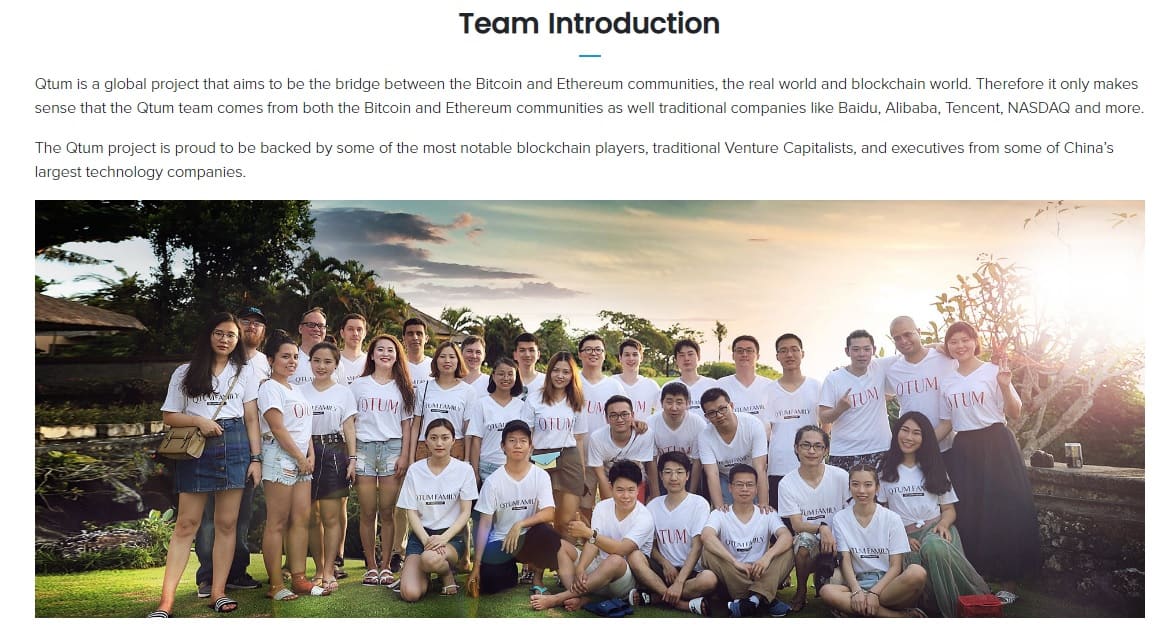
To become a leading blockchain company and technological innovator, the Qtum team held a fairly high-profile ICO from 16 March to 15 April 2017. They raised over $10 million within the first 20 hours of the ICO's launch and a total of $15.6 million in investments. The company issued 100 million coins, a number that continues to grow by 1 million every year. A team of 30 took part in creating Qtum's blockchain and cryptocurrency, including the following employees who played a significant role:
- Patrick Dai, the company's founder, graduated from Draper University. Before that, he was an employee at Alibaba and tried his hand at blockchain development. He has extensive knowledge and skills in the industry, including blockchain technology.
- Neil Mahi has 20 years of knowledge and a lot of experience in developing superior software. During that time, he worked in the blockchain technology industry for four years. He earned the title of Master in Business Administration by ISCAE. Moreover, he's a top computer scientist and can speak four languages fluently.
- Jordan Earls is one of the many famous members of the cryptocurrency enterprise group. He mastered software development at the age of 13.
- Baiqiang Dong graduated from a university in Beijing, where he majored in Theoretical Mechanics. Previously, he worked at several large companies, including Cheetah Mobile.
What is Qtum (QTUM)?
Qtum is a platform that combines the performance of Bitcoin's UTXO model with an Ethereum Virtual Machine (EVM). Users can freely create and interact with decentralised smart contracts within the Qtum platform, taking advantage of the UTXO models' scalability. The project is creating a new virtual machine that will allow developers to code Rust-based smart contracts that will work in conjunction with EVMs. Read our blog article What is Ethereum (ETH)? to learn more about Ethereum.
The Qtum blockchain network operates with its own token called QTUM and is supported by peer-to-peer node operators that use a consensus validation mechanism. The team's two primary goals are to explore the solution for technological and economic problems.
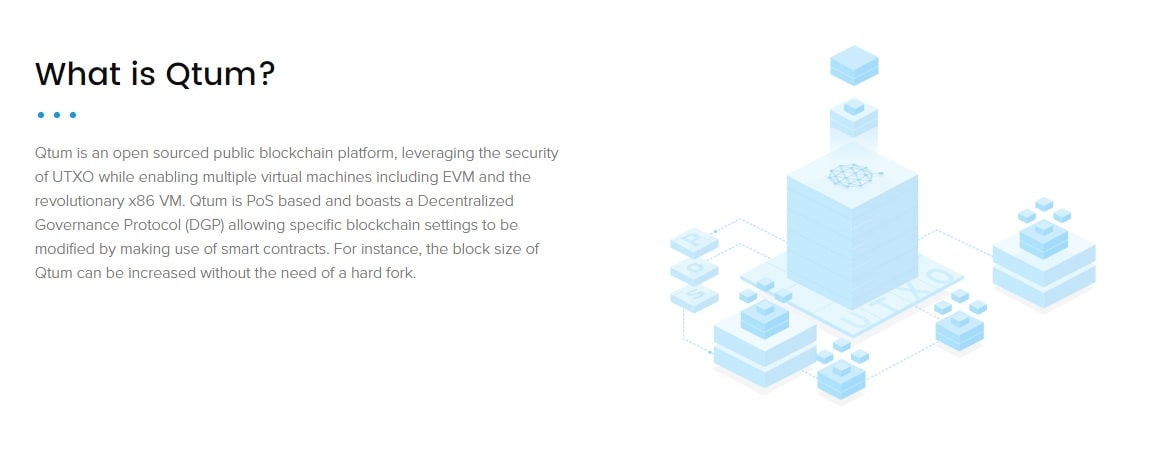
The technical problem is quite complicated. To understand it, you need to have a lot of knowledge of and skills in blockchain technology. Scalability and blockchain interoperability are the tip of the technological iceberg. That's why we'll go straight to the financial and economic problems. Qtum's primary function is to integrate blockchain technology in various industries, including finance, social networking, gambling, online publishing and more.
Because of this, QTUM developers decided to create a flexible, easy-to-use network. The blockchain's main advantage is its use of smart contracts, which refer to both off-chain and on-chain. The project's creators managed to significantly extend the scripting languages from Bitcoin's core, which, in turn, made it possible to launch smart contracts that function based on UTXO protocols. It's worth noting that all existing Ethereum apps can now synchronise with Qtum with minimal coding edits. To answer the question 'What is Qtum?', let's look at the following technical points:
- The Qtum framework is an Ethereum architecture that functions using a Bitcoin protocol called UTXO.
- It uses an effective security system, Blank Coins Proof-of-Stake (version 3.0).
- It has the ability to quickly implement the latest Bitcoin developments and all available extensions related to blockchain technology in one way or another.
- It quickly syncs with Ethereum applications, which, in turn, makes it possible to transfer existing projects directly into Qtum.
- The opportunity to make any monetary transaction directly from your smartphone without specifying personal account data.
It's worth mentioning that the main role of algorithms with ownership proof is to create classic Proof-of-Stake (PoS) protocols, which reliably protect blockchains from possible hacker attacks and reward all users who stake the cryptocurrency.
How Qtum (QTUM) works
Since the ICO, the project has developed actively, but the main principles of its operation remain the same. They are:
- An Ethereum virtual machine (EVM)
- Bitcoin's blockchain and its underlying Unspent Transaction Output (UTXO) protocol
- A private proprietary network called Account Abstraction Layer (abbreviated as AAL)
Qtum's founders chose Bitcoin's code for its reliability and the presence of the aforementioned Unspent Transaction Output protocol. In brief, the UTXO protocol plays a key role in providing security against duplicate transactions and allows for reliable, secure procedures for executing any transaction. That means that it's impossible to cancel or completely replace an executed transaction. Based on this, we can conclude that contracts or agreements remain unchanged.
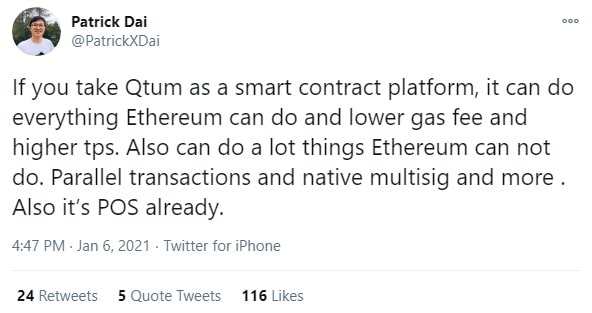
At the same time, the Ethereum Virtual Machine can be used as a basis for creating decentralised applications (dApps). And that's where the consensus protocol called Proof-of-Stake (PoS) was borrowed from. With its help, token mining can be abandoned entirely, and the entire process of creating a new block and verifying monetary transactions can be simplified. Because the developers eschewed crypto mining, most QTUM tokens were created during the project's initial launch. If you're new to mining, please read our tutorial on Cryptocurrency Mining for Beginners.
To ensure the full interaction of all Bitcoin and Ethereum elements, a personal development called Account Abstraction Layer from Qtum Foundation is used. The developers specify that the Account Abstraction Layer (AAL) component plays an interoperability role between the Bitcoin blockchain and the Ethereum Virtual Machine. That's where we need to look more closely at the differences between the storage principle for Bitcoin and Ethereum.
- Bitcoin's blockchain uses many different addresses on just one kind of wallet. This makes hacking more difficult, but this kind of wallet can become inconvenient due to the multiple private keys needed to access funds.
- Ethereum uses the principle of registering a personal account. Here, users keep all the cryptocurrency they have on only one personal account. Its use is simplified, but the level of security is much lower than Bitcoin's.
The Account Abstraction Layer provides a simulation of an Ethereum personal account with free access to each set of personal addresses from the Bitcoin blockchain. Using this kind of account is easy enough, and the level of security is about the same as Bitcoin's. The result is a successful combination of ease of use, functionality and a high level of security.
Qtum (QTUM) mining
Qtum doesn't have mining in the traditional sense. Instead, the type of mining it does offer is entirely based on the previously mentioned technology called Proof-of-Stake, which is undergoing a renaissance with the emergence of new DeFi applications. This technology is considered to be the simplest type of mining. To start receiving rewards for maintaining transactions within the network, users need to stake their cryptocurrency.
The chance of generating a block doesn't depend on the number of coins stacked; instead, it's determined randomly. Each QTUM in a user's wallet is a lottery ticket that gives them a chance to create a new block. Right now, it takes 2 minutes to generate a block, and the reward for this is 4 QTUM. According to the team, they won't change either the block generation speed or the reward amount in the future.
Qtum (QTUM) features
The Qtum cryptocurrency was able to harness Bitcoin's powerful core technology and various account abstraction layers. Together, the platform was implemented on different types of networks, including the Ethereum Virtual Machine. These layers connect EVMs and one of the UTXO transaction models to each other, creating a cross-platform smart contract and entirely new master projects, so-called oracles.
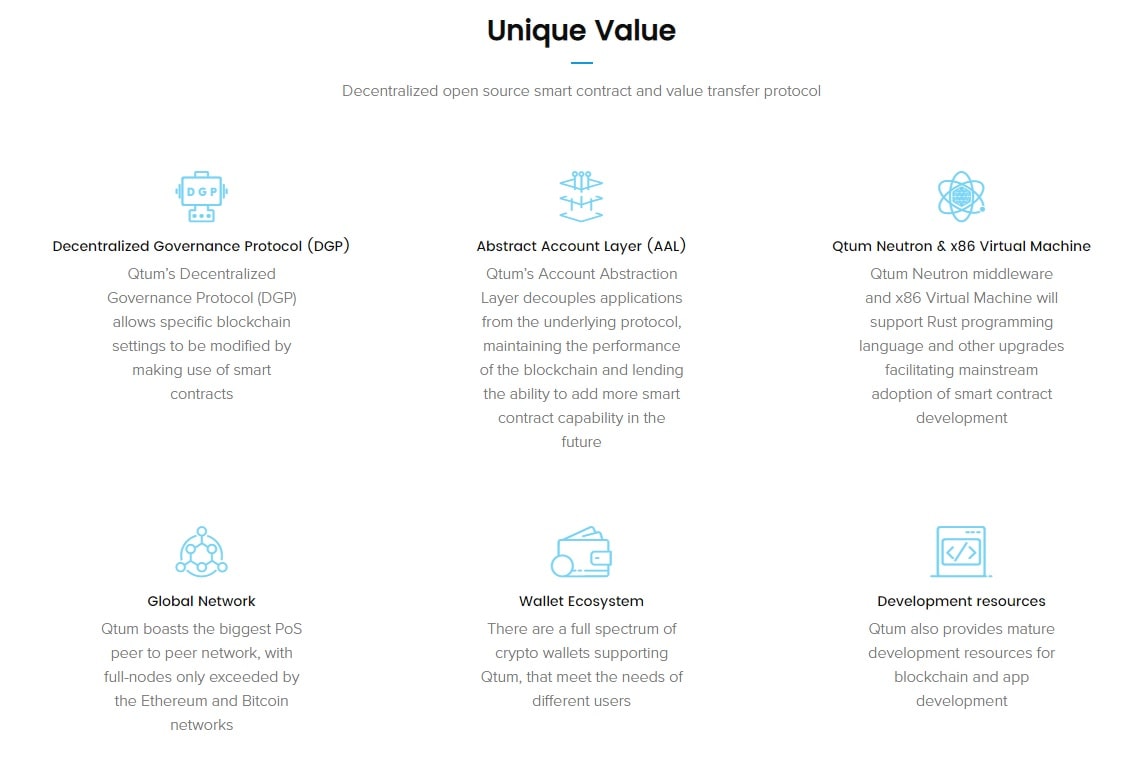
The proof-of-stake consensus protocol ensures Qtum can be supported with other blockchain networks through mobile devices. The PoS protocol eliminates the centralised production of QTUM tokens in large numbers because live users confirm transactions.
The high level of decentralisation allows users to vote for changes to the platform and offer new projects, thanks to the implementation of the DGP protocol (decentralised governance protocol). At the same time, the consent of the majority of participants is required to activate updates.
Qtum (QTUM) price analysis
Qtum (QTUM) is ranked 104th among cryptocurrencies by market capitalisation at $623,579,135. The circulating supply is 104,150,488.00 of 107,822,406 QTUM since all coins were issued before the project's launch due to the PoS algorithm. One QTUM token is worth $5.99. Here's an overview of Qtum (QTUM):
Dash (DASH) Price Today (05 May 2022) | $5.99 |
Market Cap | $623,579,135 |
Circulating Supply/ Max Supply | 104,150,488 / 107,822,406 QTUM |
Daily Trading Volume | $645,603,505 |
All-Time High | $99.87 (7 January 2018) |
All-Time Low | $0.77 (13 March 2020) |
Official Website |
Qtum (QTUM) price history
When QTUM was first listed on exchanges on 13 September 2017, it was priced at $12. The asset traded within the $7-$17 trading range until November of that year. On 13 December, Qtum managed to break past the $17 resistance level and kept rising to $99 by 7 January 2018. The growth coincided with Qtum's participation in BlockShow Asia in November. Before this event, the QTUM cryptocurrency was undervalued.
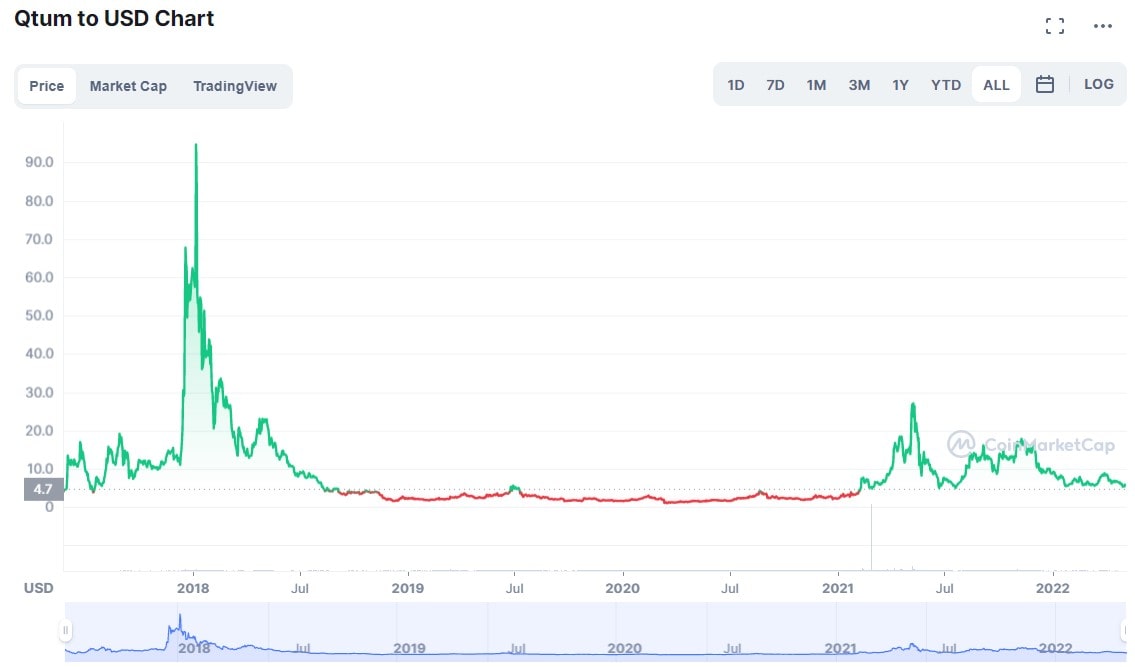
Although it set an all-time high, QTUM's growth was temporary. At that time, Bitcoin's price dropped and affected all other cryptocurrencies. QTUM was no exception, dropping to $12 by 7 April 2018, its original listing price. Although this was followed by a quick rebound to $25 by 30 April, QTUM continued falling, trading for $1.40 by early December. QTUM ended the year at $2. QTUM is currently trading at $6.
Qtum (QTUM) price prediction 2019
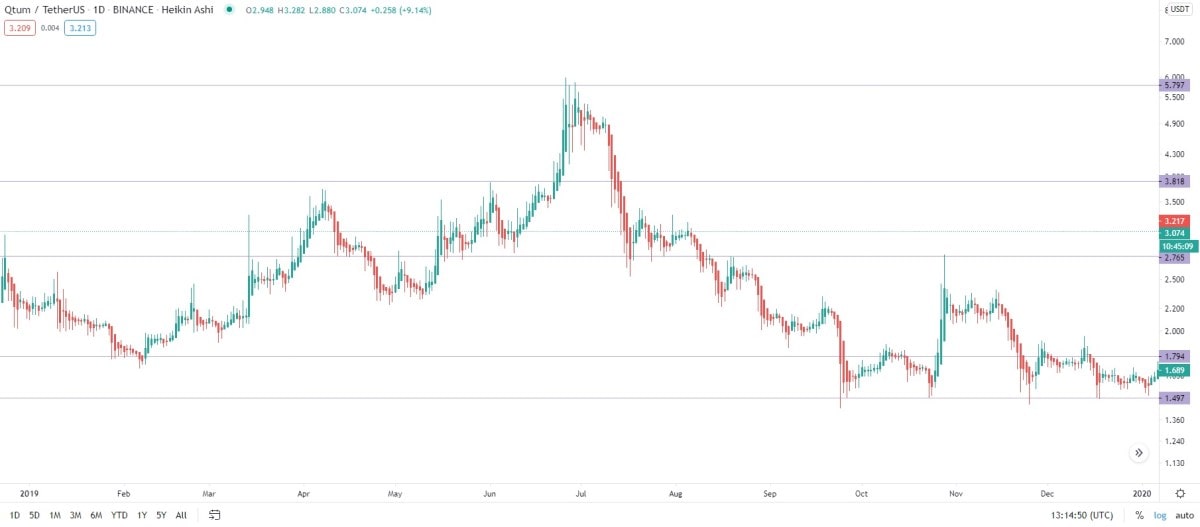
At the beginning of 2019, QTUM's price slightly declined, falling to $1.70 on 4 February. That's when buyers supported the price level and reversed the trend to the upside, taking QTUM's price to $3.70 on 7 April. Following a pullback to $2.20 on 22 April, the asset continued to rise, peaking at $6.90 on 26 June. However, the consolidation of around $5-$6 led to a breakdown. In early July, sellers stepped in and dragged QTUM's price down to $1.40 by mid-September. Even though sellers didn't break the support, it didn't grow much either. For the rest of the year, QTUM ranged between $1.40 and $2.40, finishing the year at $1.60.
Qtum (QTUM) price prediction 2020
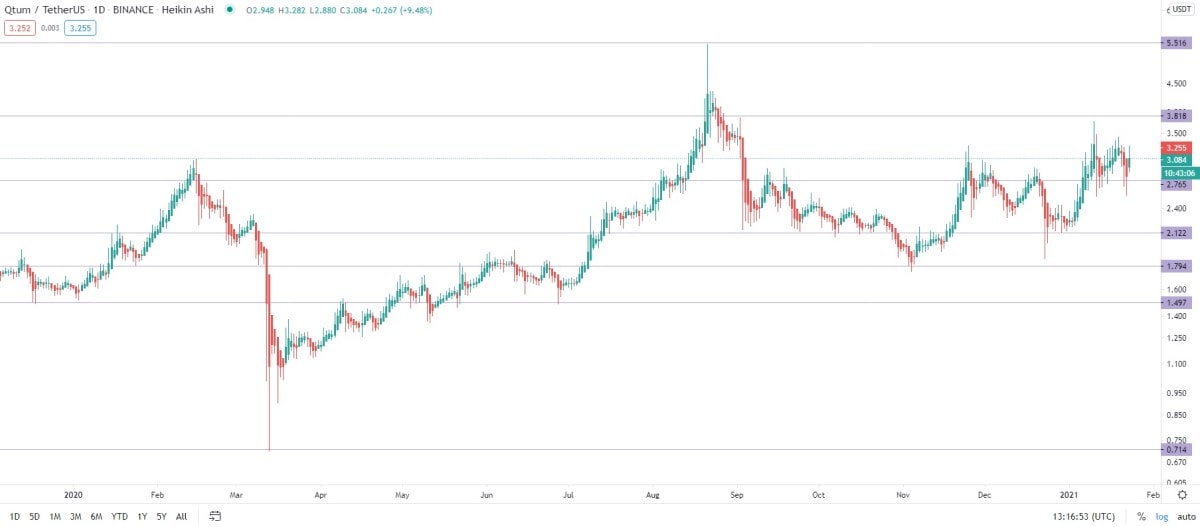
When looking at the QTUM 2020 price prediction, one can conclude that the asset performed better than in 2019. QTUM started 2020 on a positive note, with its price doubling from $1.50 to $3 on 15 February. When all markets tanked amid the coronavirus pandemic, QTUM tanked, too, falling to as low as $0.77 by 13 March.
The next day, the asset managed to find its way above $1 and kept rising slowly and surely through June and July. Although it hit $5.50 on 21 August, the asset failed to secure newly conquered support at $3.20 and pulled back to $1.70 by early November. QTUM traded within the $1.70-$3.20 range through the end of the year.
Qtum (QTUM) price prediction 2021
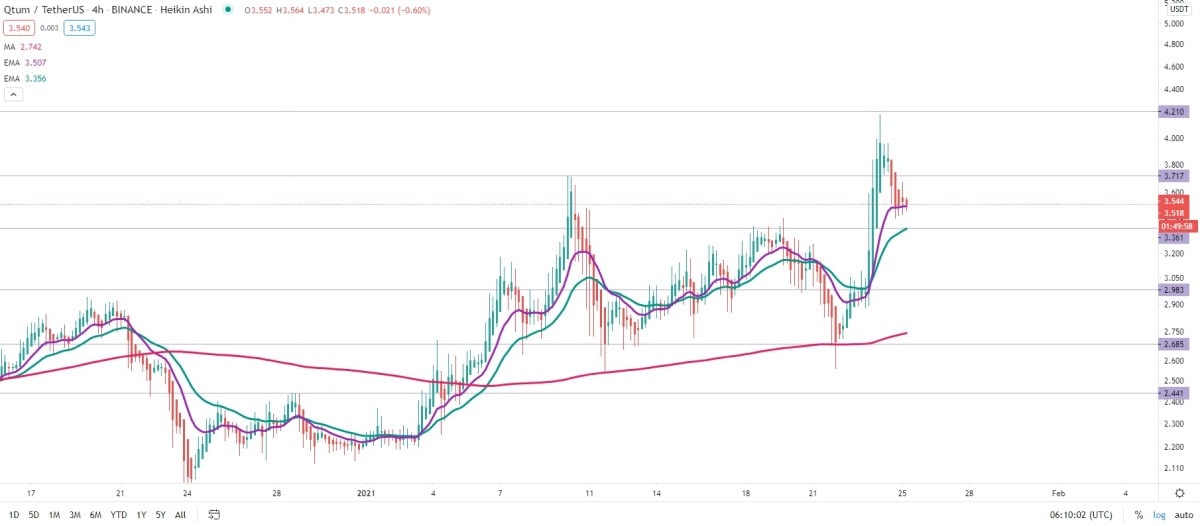
In 2021, it was also swept along with other currencies in the bull run, but it was unable to reach high enough to take out its all-time high. The price fell to the support at $5 and has since managed to move up about 150% from there. This may seem like a lot of growth, and perhaps it is. But there is still a way to go if bulls ever want to set new all-time highs in the coming years.
QTUM/USDT price chart
Qtum (QTUM) technical analysis
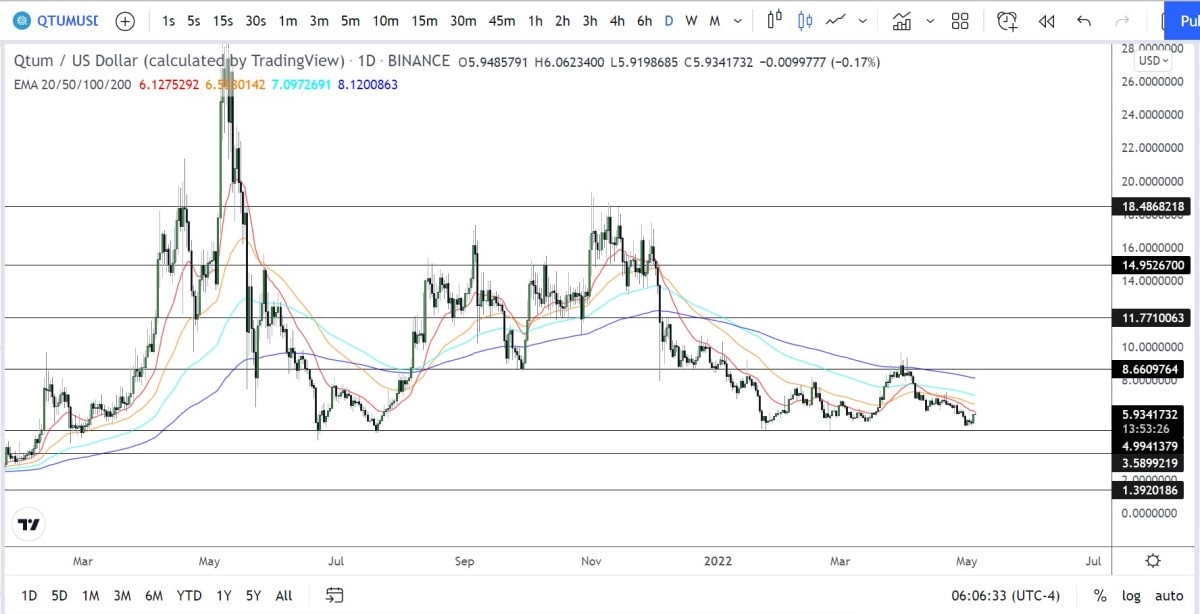
Following the daily QTUM/USDT chart as of 4 May, we see that the cryptocurrency is currently trading below the golden cross of the 200-Day Moving Average (200MA) and 50- and 100-Day Exponential Moving Averages, respectively. Since the price corrected to $18.48, the price has moved steadily downwards. There has been selling pressure across the crypto market in general since the bull run ended in May 2021, and QTUM was no exception. The asset is currently trading above the support around $5.93, but multiple hits of the said support would likely weaken the zone enough for bears to break below it.
Qtum (QTUM) price prediction for 2022, 2023, 2025 and 2030
Some of the technical developments for the project are truly magnificent. However, this niche is pretty competitive, with other players like Cardano, Ethereum, EOS and Chainlink staking a claim. The project's popularity will depend on the applications created on it and the partnerships its development team manages to conclude.
We gathered the most reliable Qtum future price predictions from experts to find out their opinion about the project. Every crypto price prediction should be treated with caution, and the same is true of Qtum price predictions, as well. Please always consider the risk of investing based only on price predictions.
TradingBeasts Qtum (QTUM) price prediction for 2022, 2023, 2025 and 2030
Per TradingBeasts' Qtum price prediction, QTUM's price will not rise by much in the coming months, and the asset will close 2022 at around $5.26. It gets better for QTUM from 2023 as TradingBeasts predicts that its price will reach as high as $8 before the end of that year. In 2024, QTUM is predicted to grow by over 50%, with its value stabilising at around $9.20 by the end of the year.
WalletInvestor Qtum (QTUM) price prediction for 2022, 2023, 2025 and 2030
Following WalletInvestor's Qtum price prediction, QTUM is a relatively good mid to long-term investment. They predict that the asset will rise by over 57% in one year. It gets even better as longer-term investors can expect to see QTUM's price at $25.16 by 2027.
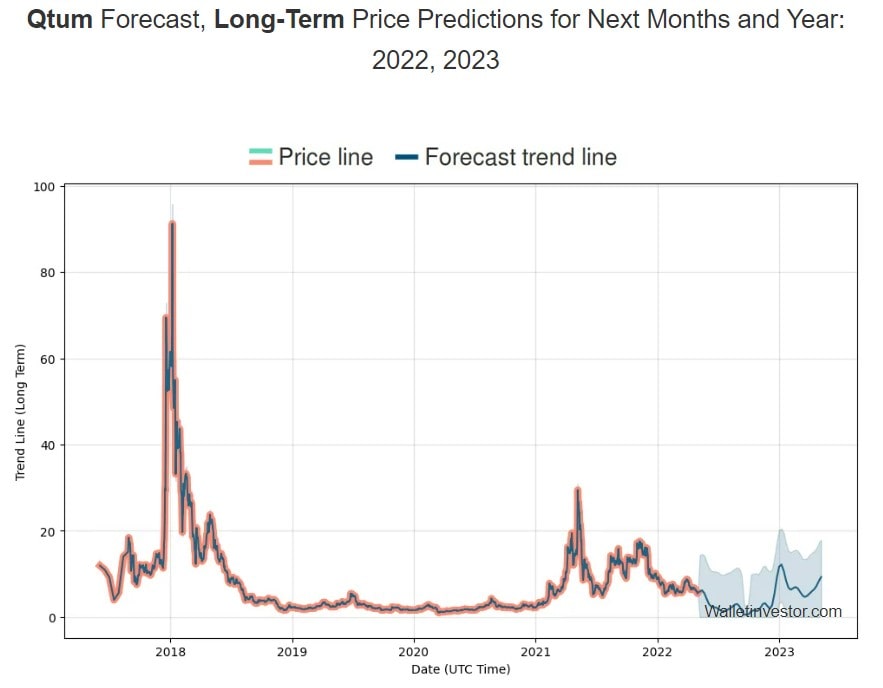
DigitalCoinPrice Qtum (QTUM) price prediction for 2022, 2023, 2025 and 2030
According to DigitalCoinPrice's Qtum future price prediction, the QTUM token's price may rise significantly in the coming years. They predict that Qtum will grow to $9.42 in just one year. QTUM will keep rising and may reach $17.05 by 2026 and $28.21 by 2030.
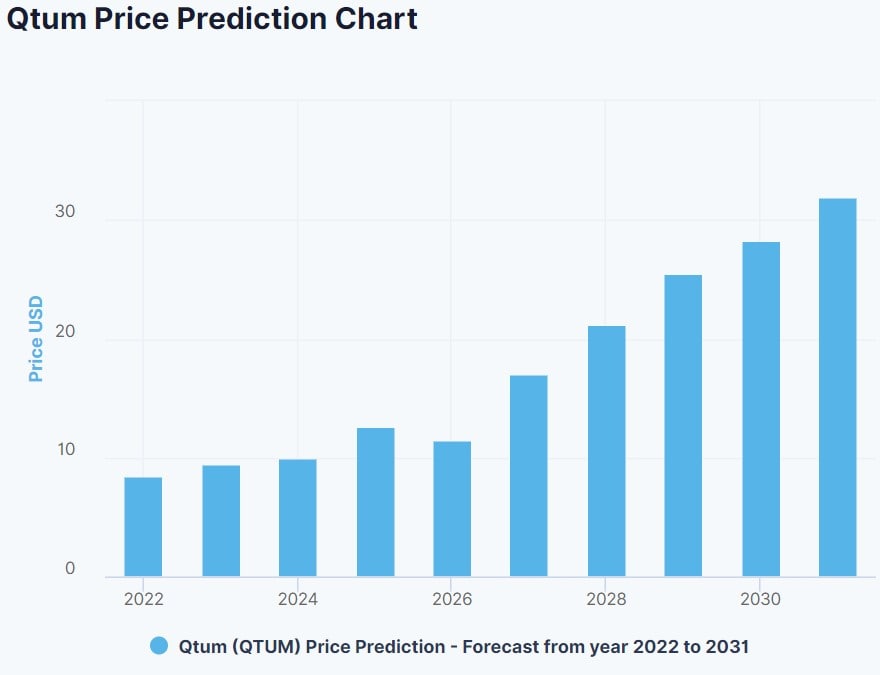
Qtum (QTUM) overall value predictions in the future
The QTUM project offers exciting and promising technology, which is a real breakthrough in blockchain development. However, the coin itself has currently fallen on hard times: since the spring of 2018, we can observe a gradual decline that continues to this day. The project has reached its historical low in terms of satoshi.
Will Qtum (QTUM) go up?
Many cryptocurrency experts believe that the QTUM price is in a deep correction phase and may soon show rapid growth. Their opinions coincide with the charts, and the probability that the asset will continue to grow is high enough.
Qtum's (QTUM) price prediction today
Today's Qtum price prediction indicates that the asset has every opportunity to consolidate and strengthen its growth. But the project's team has no time to relax because the competition is intense. Only the best projects will succeed.
Tags
Try our Bitcoin Cloud Miner and get additional crypto rewards based on your trading volume. It's immediately available upon registration.
Try our Bitcoin Cloud Miner and get additional crypto rewards based on your trading volume. It's immediately available upon registration.



